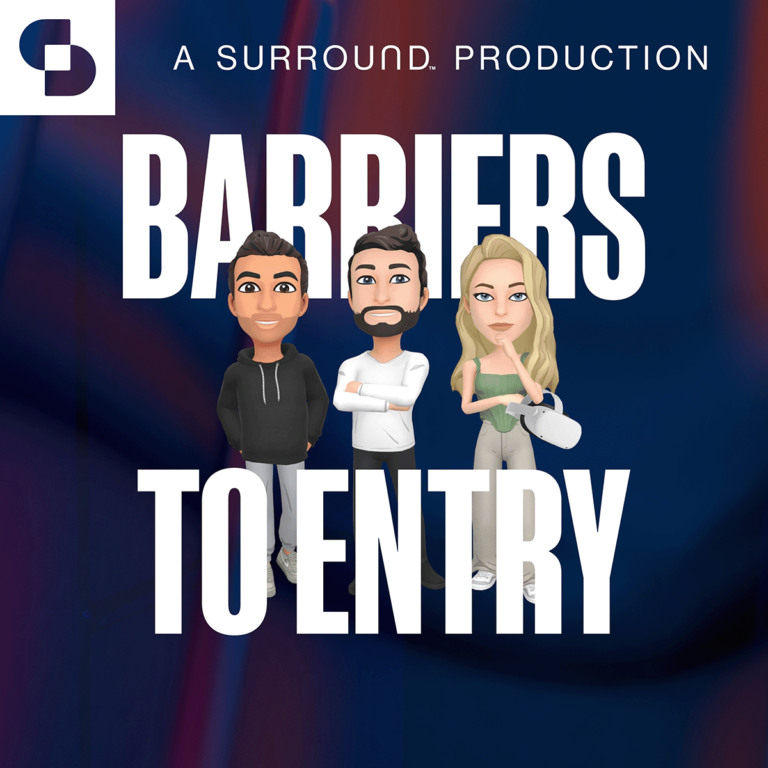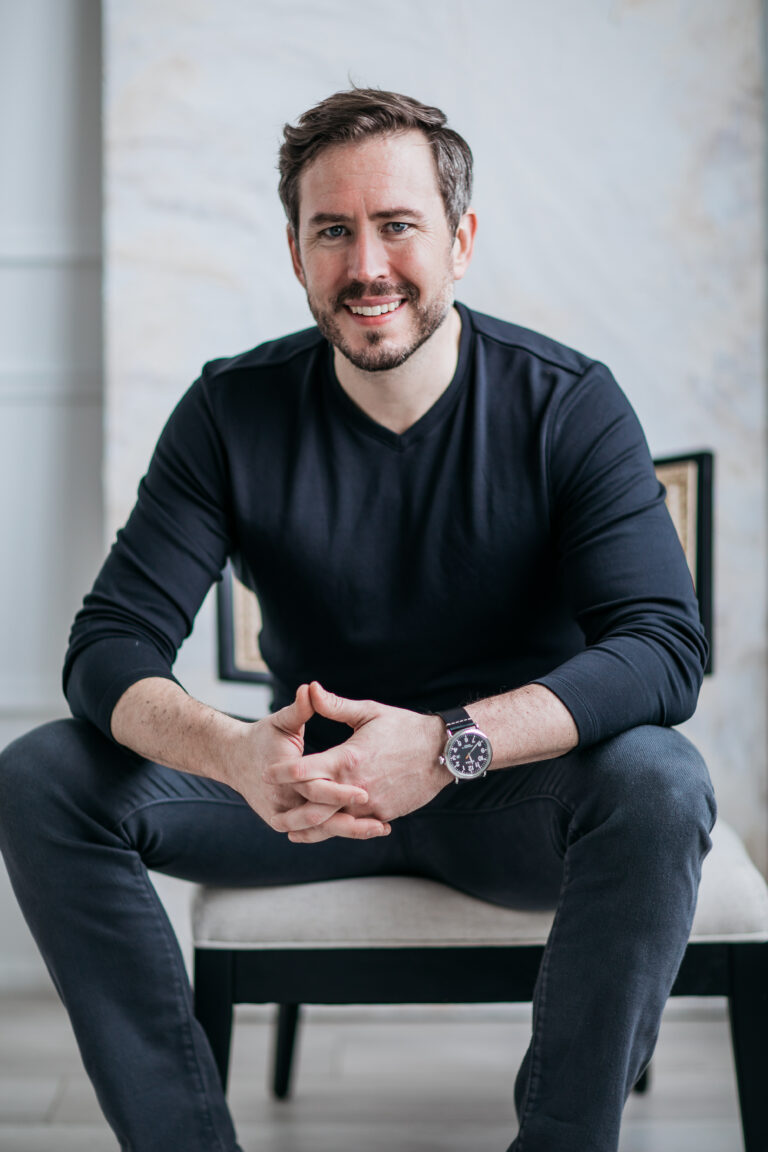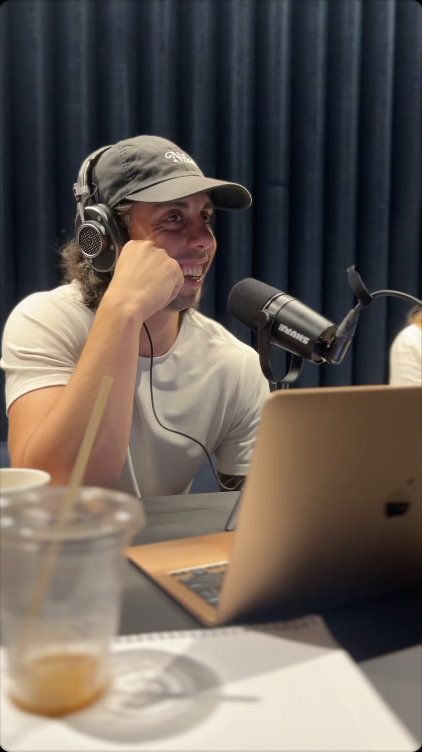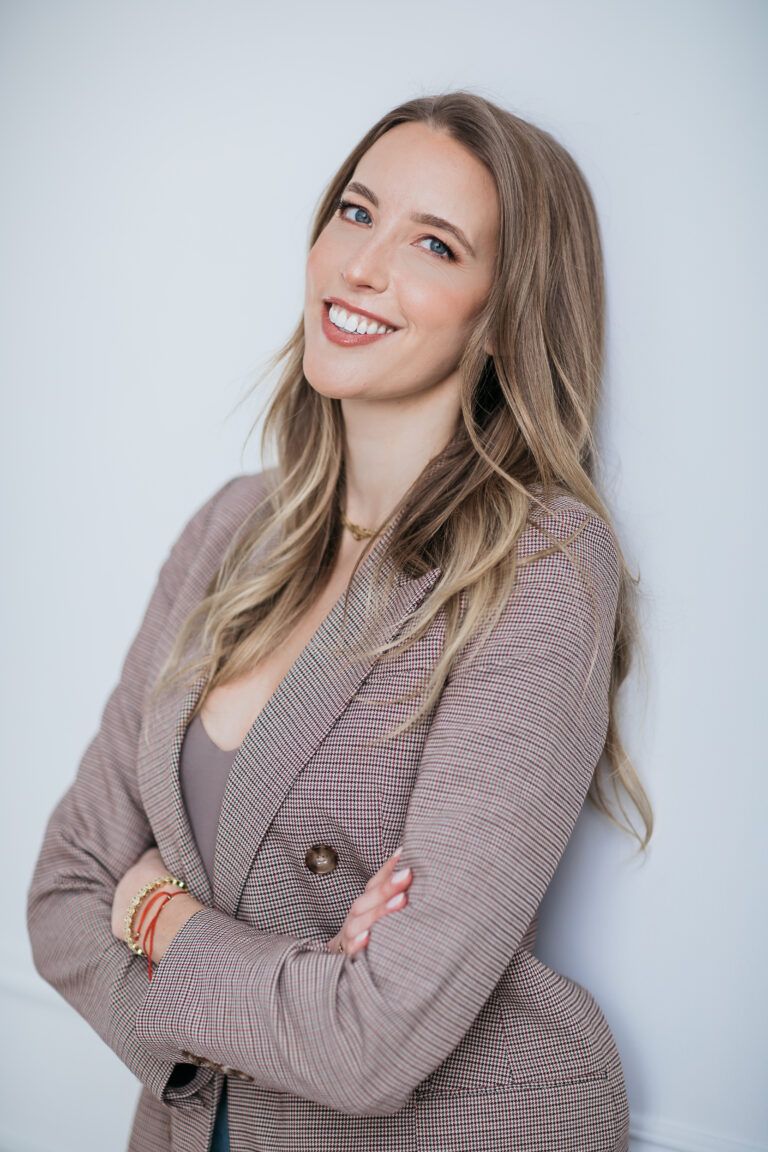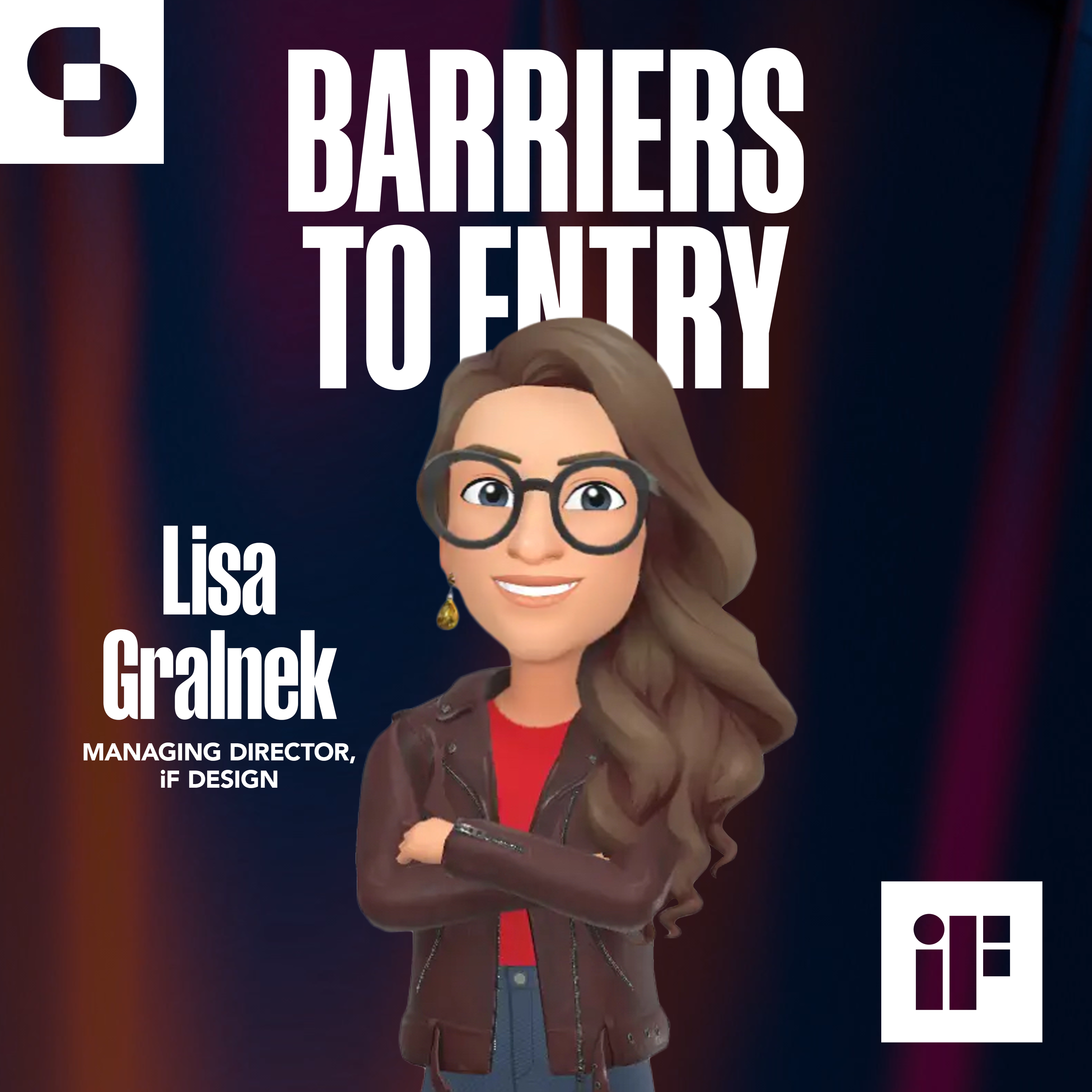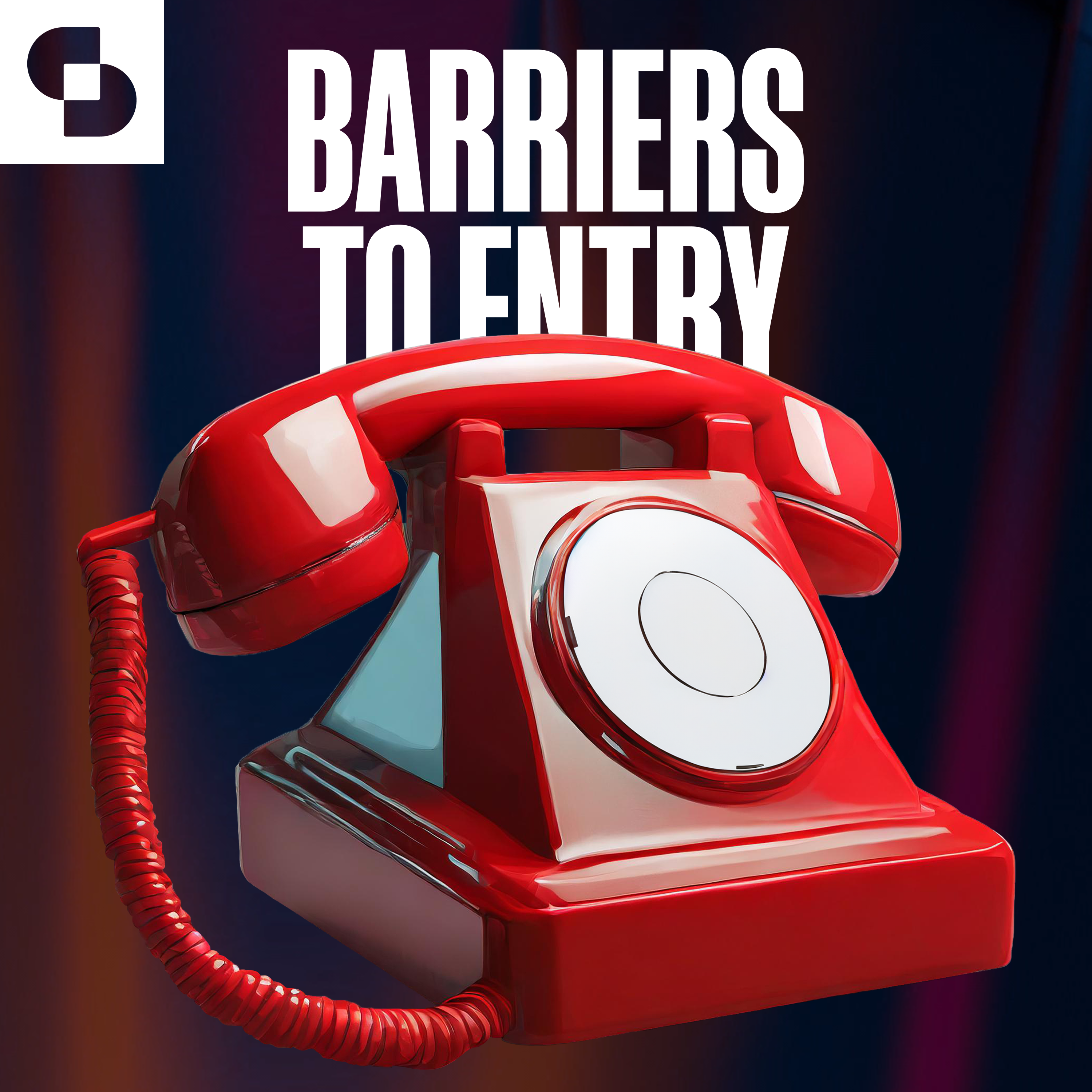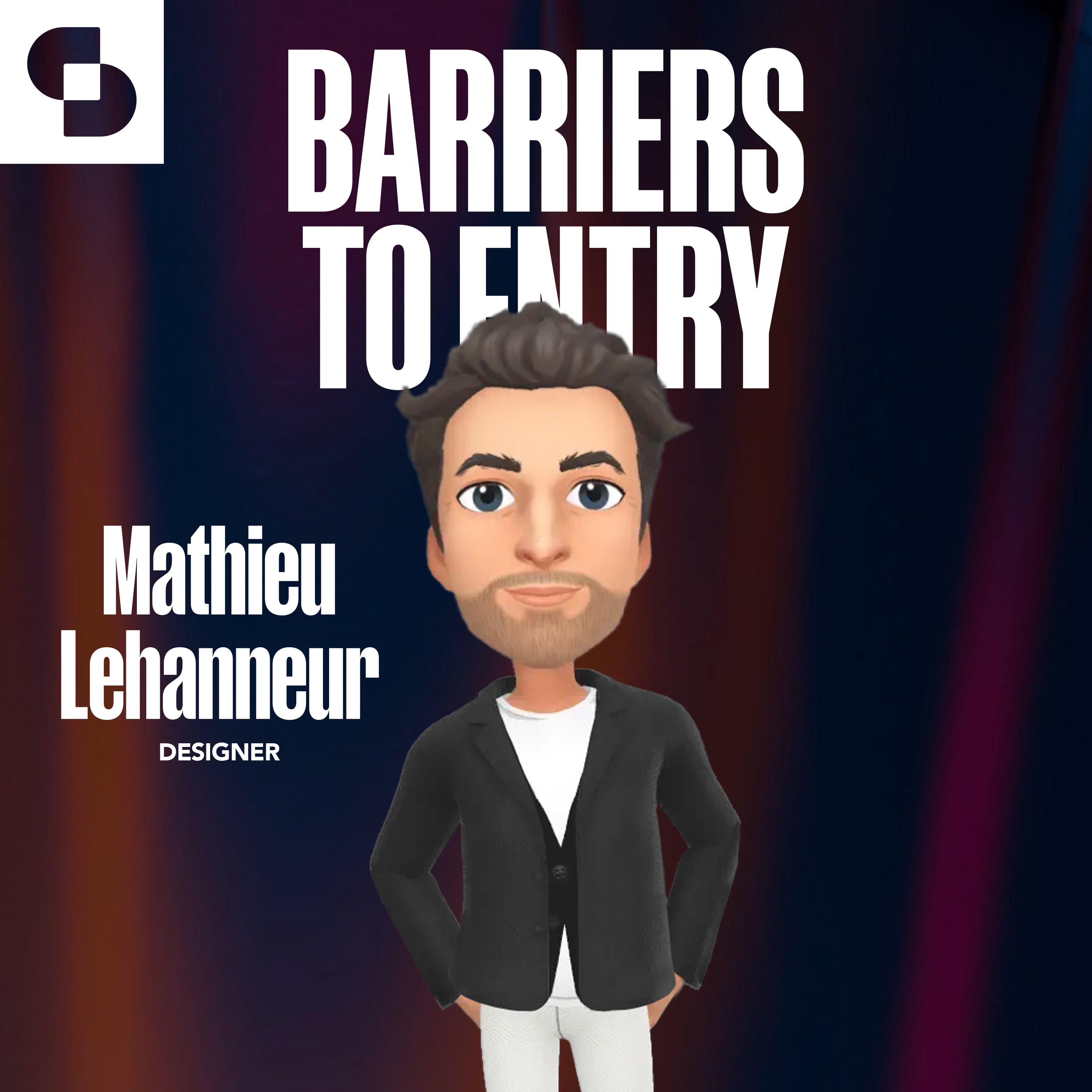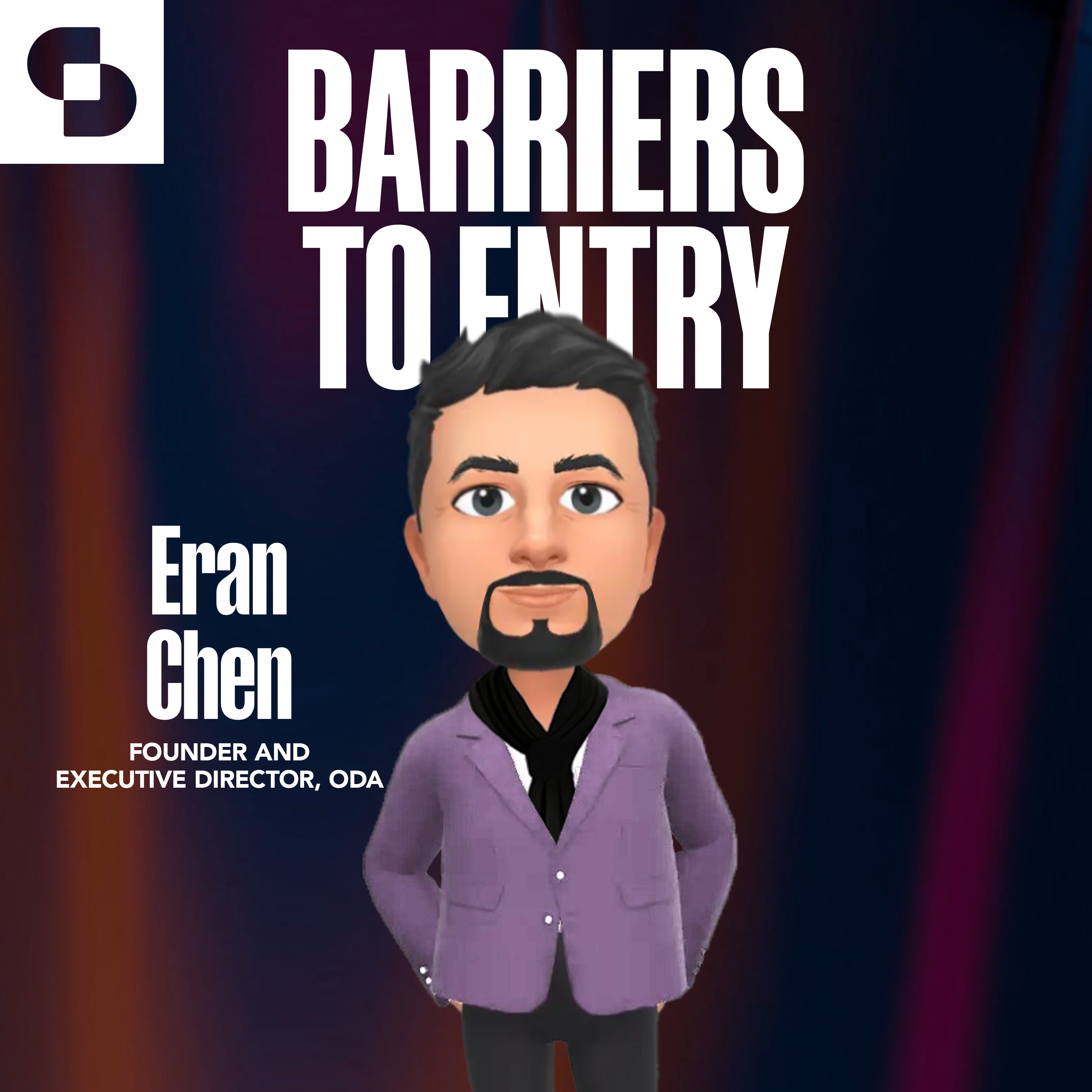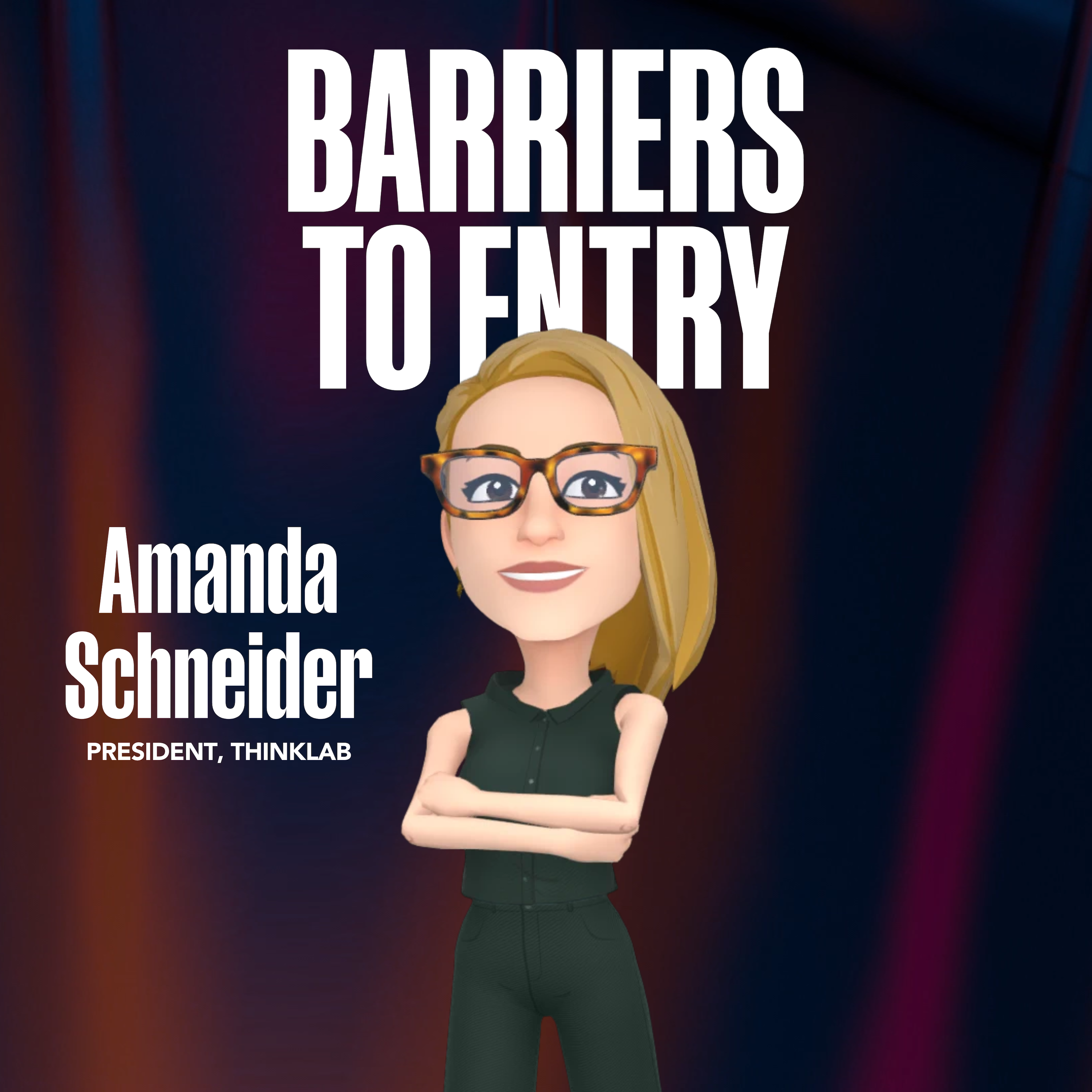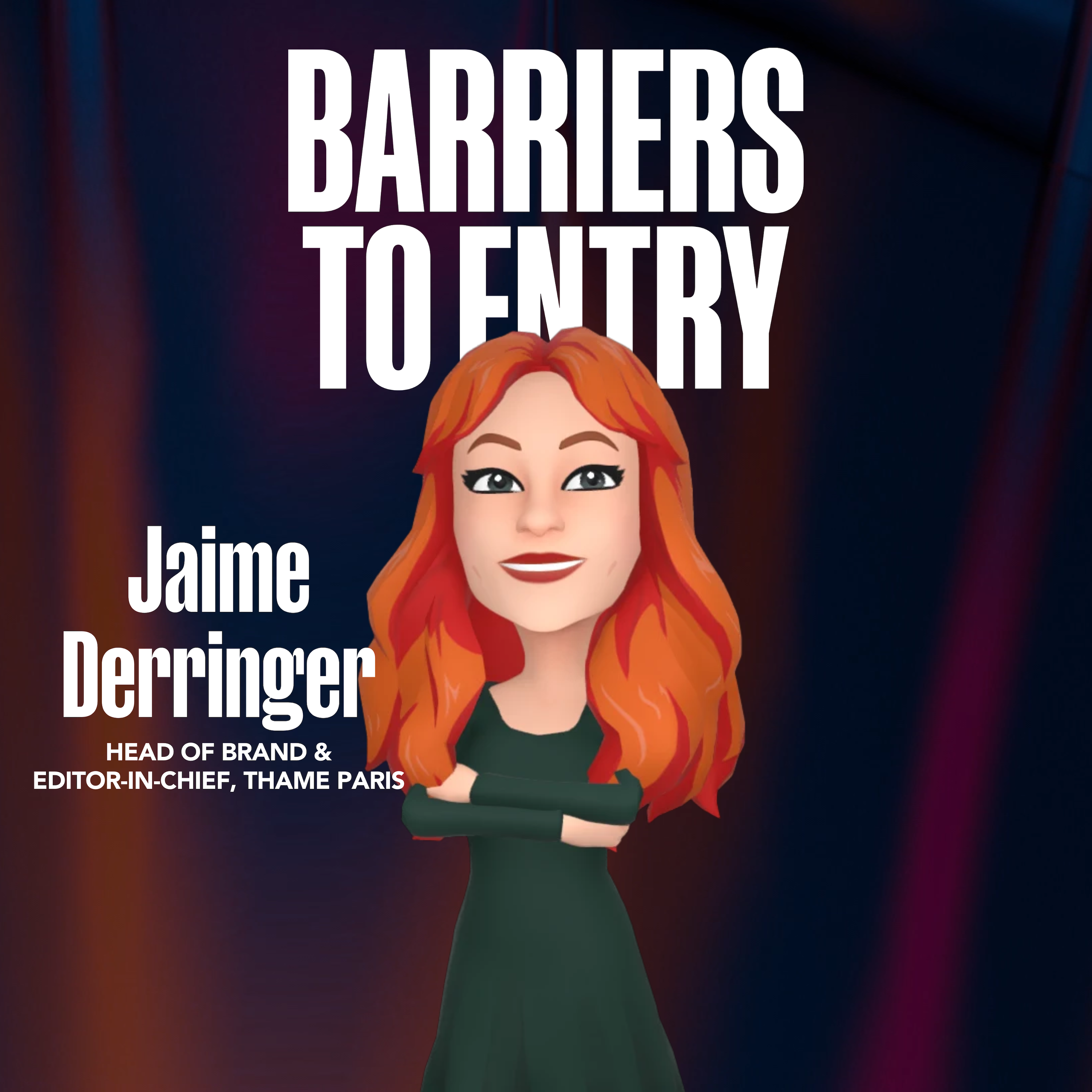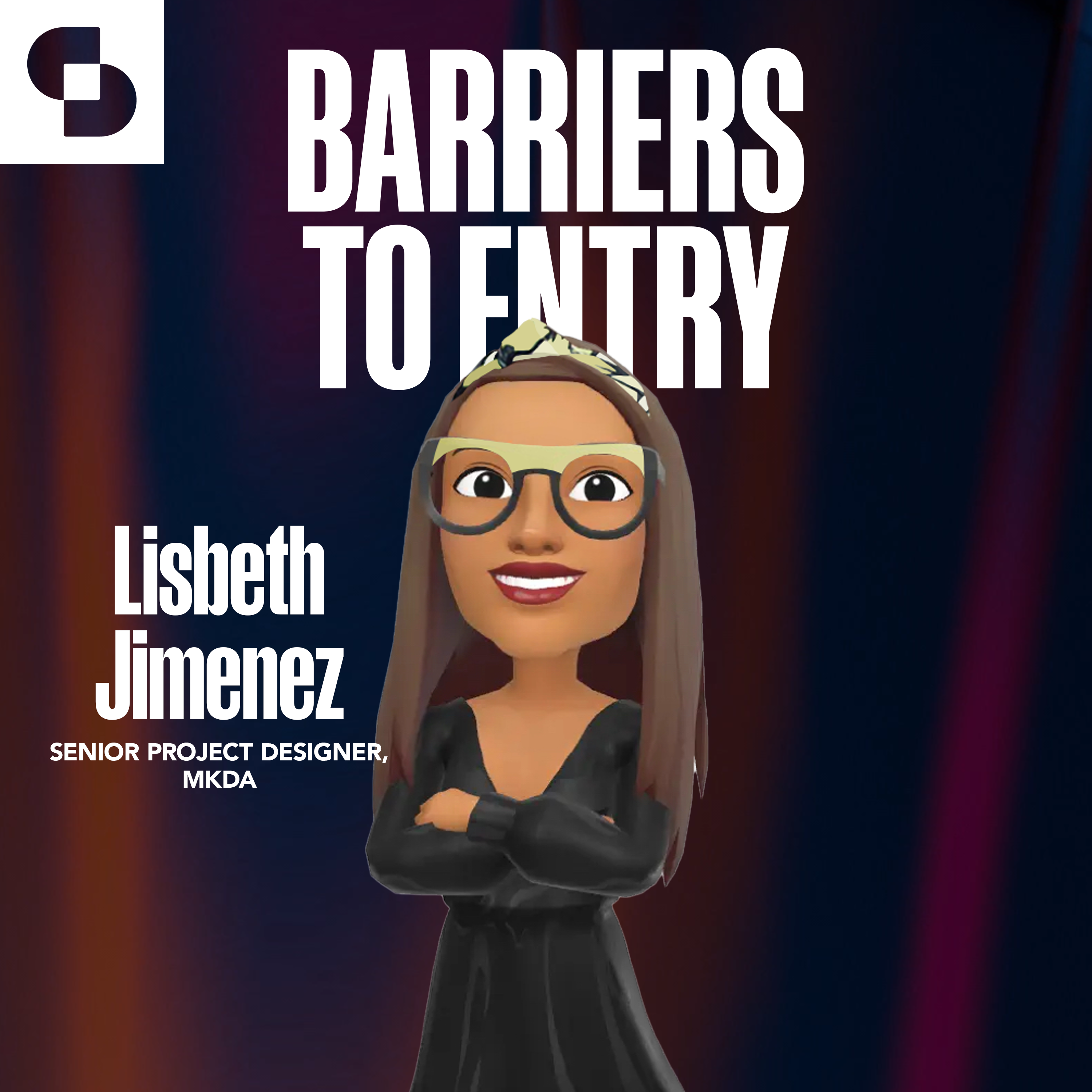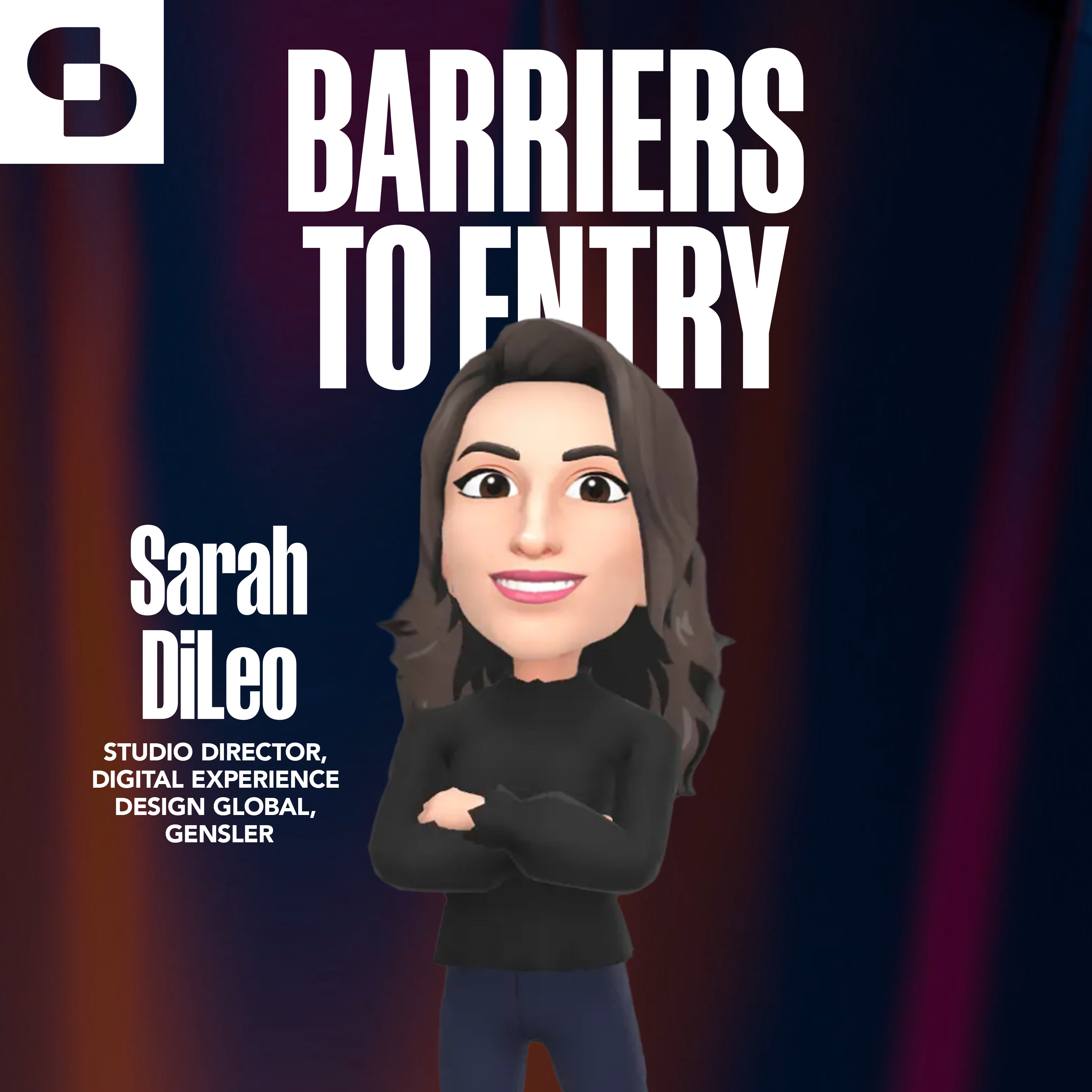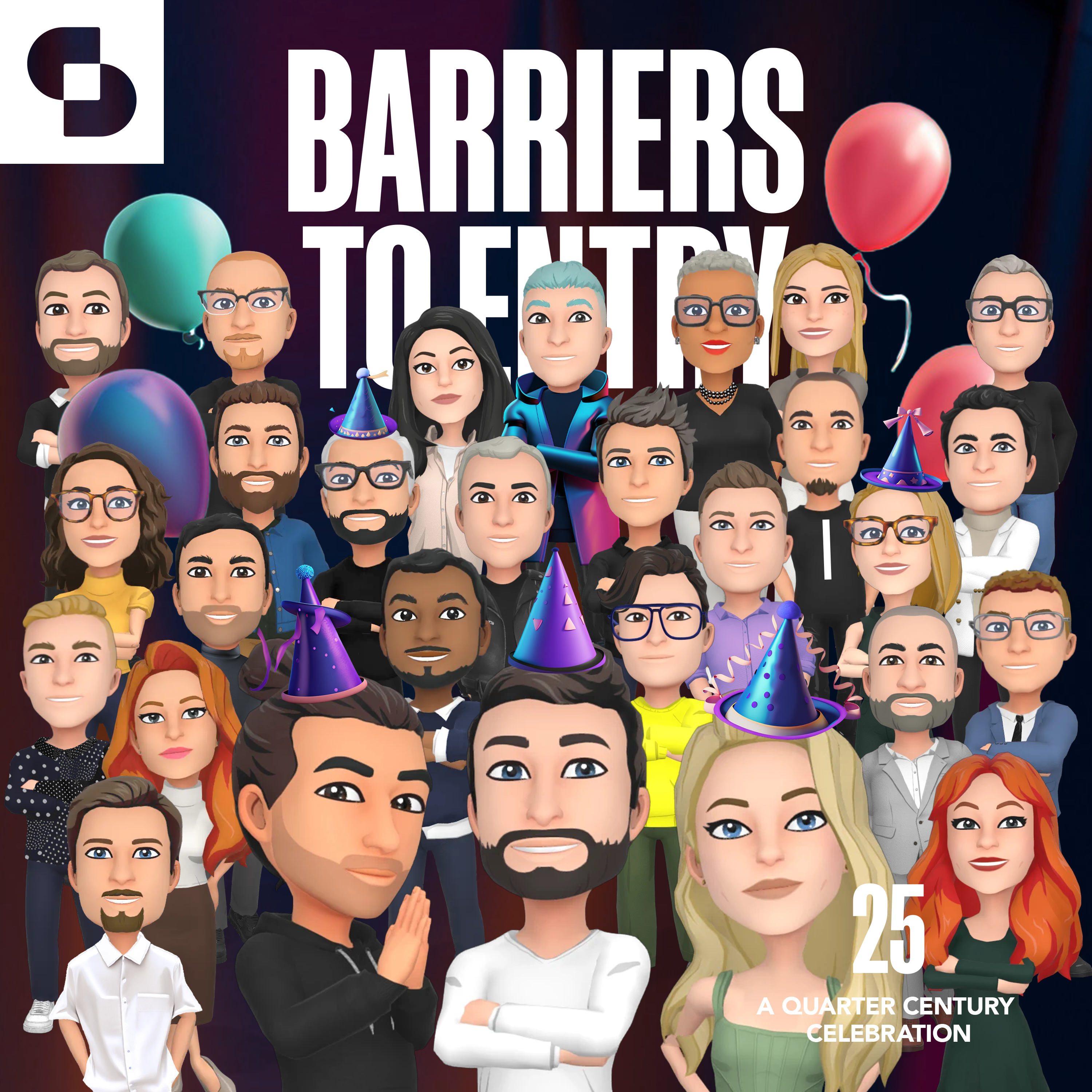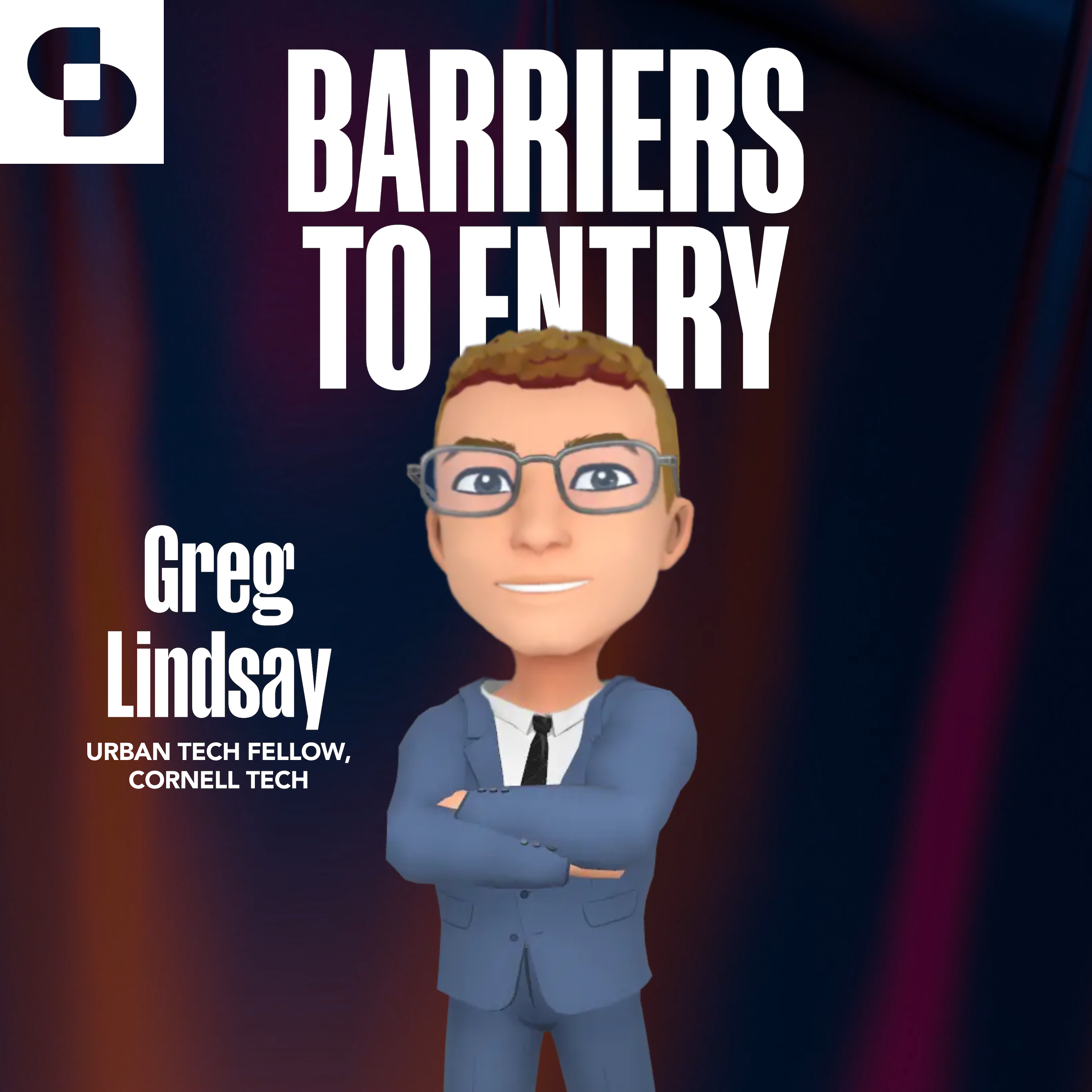This week the gang welcomes German-born innovator and Founder of the notable A&D digital publisher Architizer and New York-based HWKN Architecture, Matthias Hollwich, for a wide-ranging discussion on business, innovation, Web 3.0, designing in the Metaverse and more. From how broken legs make you more social to handing our future over to (hopefully) intelligent machines, you won’t want to miss this one.
Connect with Matthias Hollwich on LinkedIn!
Moments to check out:
- Designing your business and partnerships for innovation (starts at 9:33)
- Web3’s potential to address the problems of Web2 (starts at 15:09)
- Thinking about how to design for a Metaverse environment (starts at 22:30)
- Digital twins, AI and the future of work, life and talent (starts at 35:23)
- Plugs and resources (starts at 44:25)
Transcripts, show notes, and links to resources for each episode of Barriers to Entry can be found at surroundpodcasts.com/barriers-to-entry
Connect with our hosts on LinkedIn;
References and resources:
Discover more shows from SURROUND at surroundpodcasts.com. This episode of Barriers to Entry was produced and edited by SANDOW Design Group. Special thanks to the podcast production team: Hannah Viti, Wize Grazette, Kasey Campbell, Rob Schulte, and Samantha Sager.
Matthias H: [00:00:00] When I look back into architectural history and urban planning and so on, we not very often have made the right decisions, right? So we cannot take the high ground and say like, oh no, we had figured it out much better. I embrace AI actually much more of hopefully helping us to fix some of the issues, um, and to create a better city, better buildings for us.
Um, but we have to find our place now as, as humans in a new world where we have suddenly an intelligent partner.
Bobby Bonett: Welcome back to another addition, a new episode of Barriers to Entry, the podcast where we get into it with the thought leaders, the provocateurs, the principles, the designers, the trendsetters, the trailblazers, the pioneers, and everyone thinking about web3, the Metaverse and the architecture and design industries. I’m here today with my co-hosts, [00:01:00] Tess and Andrew. Good to see you guys.
Tessa Bain: Wow. No adjectives for us. It was great to see you up until that moment I was like, Waiting, waiting, waiting. But that’s all we get.
Bobby Bonett: I thought it’d be interesting if we try it out.
No adjective today. See how it pans out. Interesting. But we’ve got, I would say, to make up for that flop in the intro. We do have an amazing guest today, uh, principal from HWKN Architects, Matthias Hollwich, who I think blew our minds. I was in a great mood after the interview, let’s put it that way. I was just excited coming off that conversation and count myself as a member of the Matthias Hollwich fan club now.
Andrew Lane: Yeah, he’s thinking about stuff in such cool ways, but also doing it all and has been doing it for so long. It’s just, it’s such a great conversation. I think that it’s ironic that we began with no adjectives, because there’s a lot of adjectives to describe how solid of a guess Matthias was. Should we just get right into it?
Let’s do it. Let’s, let’s do it.
Tessa Bain: Today on the pod, we’re thrilled to welcome a true innovator in our industry. [00:02:00] German born, he made his way to America, where he founded the notable A+D resource and digital publisher Architizer, as well as the New York based HWKN architecture. He’s been honored for his vision and innovation by publications like Fast Company and Business Insider, and he’s here today to talk Web3 with all of us.
Please welcome Matthias Hollwich.
Matthias H: Thanks for having me. Very excited.
Andrew Lane: Yeah. Excited to chat. And, and just to get right into it, you know, you’ve, you’ve founded a few really notable organizations and so going back to the early days, we’d love to hear the story of what led you to starting Architizer 15 years ago.
Matthias H: Yeah, that was a very interesting time. We saw that social media has become relevant within society, and we saw that people were able to promote themselves, communicate with friends. And when we looked into the media reality for architects at that time, it was a very, very close circle of where people were allowed to publish.
And in New York, for example, it was very controlled [00:03:00] by the New York Times. And what we tried to do is basically create a platform that empowers young architects to get an audience to promote the work, get traction in [inaudible], get commissions. And of course, what we wanted to do is we wanted to make. That we create a much more, the diverse talent pool out into the open because we have to work really hard to create better places around the world.
And that’s how the idea of Architizer was born. First, we called it Arch-i-porn, I think. Cause we just thought we have to get people really excited about it because when you look at buildings, it could excite you in one way or another, or that’s what we wanted to do. But then we [inaudible] ourselves. We called it Architizer. Um, but they became very successful, which makes us still very proud.
Bobby Bonett: Yeah, the brand really took off. Matthias, when did you kind of recognize you had a hit? Because it’s no easy feat to launch a media brand, as I understand. Yeah.
Matthias H: It started actually with our launch party. We went to the storefront for media and architecture in New York, and we were hoping that maybe like.[00:04:00] 10, 20, 30 people gonna show up. And we got mopped entirely. Mm-hmm. So we ran out of beer like I think in a half an hour, and we just went to the next daily and bought more beer. And I mean, everyone was just so excited. I ran into some of these legendary people that I had read about and they all showed up.
So that was the first moment where we realized that we had something that really triggered interest in people. But then also very quickly, right. Our subscriptions, it just went up and up and up. And I think after two years we had like 2 million unique visitors every month. Mm-hmm. And that was something we did not expect.
Bobby Bonett: How did that affect your career in architecture? I mean, I’m sure that was a full-time job in of itself, and then maybe the quick success was unexpected. Did you have to take your eye off your core passion for a moment, or did Architizer enable you to maybe supercharge your own personal architecture career?
Matthias H: Yeah, so the good thing. That we were three people who, three plus one, we were actually four. So three people were in the day in [00:05:00] day business from Alex Steel, Mark Kushner, and myself. And then Bang Prosky was there. He was focusing more on the PR and Alex was very much on vision and technology. And then Mark and I, we had HWKN Architecture together at the time, and that was a good thing because he actually really jumped onto Architizer and made it his.
So we were basically splitting a little bit our time on both some of companies. But what was super exciting, and it’s exciting that it helped us to think also differently about our work. Uh, we saw that actually images became so important, how we communicate about our projects differently, how we frame it differently.
And so when you look now into the work we do, it is very different than the presentations that we did 15 years ago because we learned how we can speak through media. And now because everyone is consuming media, uh, they also consume differently our architectural environment, right? When you think about it nowadays, for example, Dumbo, do [00:06:00] we still know how Dumbo really looks like?
We know how it looks like from everyone who’s taking a selfie at this point with the two bridges about them, right? But this are key learnings because in the end, right, we designing buildings for people and we design them also for them, how they engage with them, how they want to see themselves in them.
And that was for me a lot of learning and I think it made the also the architectural firm stronger.
Bobby Bonett: Can you talk to us a little bit about HKWN architecture and where your sweet spot is and maybe the growth of the firm prior to Architizer and then over the ensuing years?
Matthias H: Yeah, so it started with really humble beginnings, right?
As a young firm and I just had arrived in America was just grab anything you can. So little renovations here, like a storefront. But very quickly we were able to get a little bit, maybe also through Architizer into this pop up world and we designed actually the mini rooftop for BMW mini brand.
And that was like a moment where suddenly like poof. [00:07:00] We did an event space on a roof somewhere in Manhattan and lots of celebrities came. And that helped us to really start more than just renovations. And then we also pushed into, let’s say, more unusual kind of ways how we could engage with our trade.
So for example, we never really had to design the whole building. We were also okay to take parts of it. So the first big building, we actually just designed the facade, but it was a 400 unit apartment building. So suddenly we looked bigger than we were. And so with this, we were able to grow slowly, but truly.
Uh, but then at some point also my former business partner left basically the architecture firm. I took over full kind of visioning on it and at that time we repositioned the firm because I realized my work was Architizer. I also wrote a book on aging, uh, and everything that I was excited about was always about a future of architecture and never the classic, [00:08:00] oh, here’s a building now let’s make it look good.
There was something always more that I was driven by. So that’s why we pivoted a little bit or sharpened our profile into innovation. Mm-hmm. And that’s why we are calling ourselves right now, like a boutique innovation firm. We have 25 people right now in the office. We always work in collaborations, so we act actually as 150 person firm because we have collaborating companies in London, Munich, Riyadh, Miami, New York. And so it’s almost like a network of innovators working together on these different projects. And then we love to tackle the big topics of today, right? Ultra sustainability with a building in London that is carbon neutral in its goals. We are looking into new topological ideas, like the future of the office needs to be entirely different than what we are still thinking about it.
So we created now the first work resort that’s a 350,000 square foot office building. Totally reinvented how it invites people and attracts people almost with the [00:09:00] alternative goal that employees wanna pay for going to the office because it’s so awesome and so cool. And then we are also doing a lot of new apartment apologies.
So we started a new company, which is called Flex, where we are creating intergenerational living products and technology enhancements. So that’s why I think all also the entrepreneurial spirit maybe from Archetizer. Helped me to now use the architecture firm as an entrepreneurial enterprise, but not just as a firm, but with the products that we create.
Andrew Lane: I was really excited to hear about your international network of partners. Can you talk to us a little bit about how you think about selecting those partners, how you find them, how they find you, and sort of what that co-working spirit really feels like in the innovation space?
Matthias H: Yeah. For us, first it’s about personality.We want to work with people and firms that are aligned with our values, but also with our spirit in a way. Architecture is hard. I think business is hard and it needs to make fun, [00:10:00] so that’s why we make it very personal. So trying to meet the people in person, have the conversations, see if we align in the vision.
But what I have always seen, because sometimes our partners are maybe not as out there as we are, we actually always offer them to go onto a journey with us where they say, we gonna share with you guys our enthusiasm, our creativity, and our level of innovation. You guys share with us your local knowledge and your expertise, and then we create workshops which are very un-hierarchical so that everyone can contribute on every kind of level.
And it is actually fantastic actually, got a lot of fans now where people, where we have worked with them before, they wanna work with us again. For example, Ozark in Munich, we created the , which is lead called [inaudible] Neighborhood. that created a big bus now in Munich and they changed their design philosophy through our collaboration.
And I see buildings now very differently being done than [00:11:00] before because we had that kind of very open dialogue. We have the same thing also with KSS, our friends and fans out of Philadelphia. We did the Innovation Center in Philadelphia together for the University of Pennsylvania. We became incredible friends and also their kind of way, how to talk about the work, how to present themselves has changed through this kind of collaboration.
And I think that is, for me, so important. When you start to work with other people, you need to be generous. You have to find people who are generous and you have to create a mission and a vision about growing together and not saying like, okay, we are the great guys. Now you guys have to help us just to execute on an idea. It is really about bringing everyone into that kind of collaborative space.
Bobby Bonett: I gotta say, it’s pretty excellent that. You start your firm taking any odd and end project, and now you’ve got super fans around the world who just wanna collaborate with you on your newest endeavors, that’s great.
Andrew Lane: But why start a firm if you’re not gonna have superfan? Right, Bobby? Like that. [00:12:00] Exactly.
Bobby Bonett: Why start a podcast if you’re not gonna have super fans? Yeah. Matthias, you’d also shared with us an idea on the pre-call you had, well over a decade ago to start an electronic architecture studio. What’d you learn from exploring that idea? What were the takeaways? How’s that still, you know, in informing your work today?
Matthias H: Yeah, that was actually in 1999, I started Electronic Architectural Studio. I had two partners in that venture. We got actually sponsorship from the Center for Art and Media Technology out of the [inaudible]. We were supported by the ETH in Zurich. And the idea was that because we saw that a lot of people were buying single family homes that were standardized, but it was not customized.
So we looked into a process on how architects can design singular family homes that can be customized over the internet. And we worked on the vision, the technology, the business plan, and everything aligned except the internet. We were 20 years too early. Mm-hmm. Because Bandwidth [00:13:00] logistics, mm-hmm. All of that was still much, much, much too early.
And so my takeaway was that there was an incredible learning. Just pushing and kind of having an idea and not giving up. We actually came really far in terms of having a working parametric design engine on the internet. We had actually 20 different architects who worked with us and they loved actually the work that we were doing.
Cause what we also tried to do is that you’re not gonna be paid us. On an hourly, which is normally what architects do, right? Or even if you do a lump sum, it reflects like your hours. But that there’s a licensing agreement so that architects could continue to earn money on their creation, which is still kind of a novelty today.
And all of this has kind of flown into our work right now. So with our FLX concept, we are creating a prefabricated new apartment apology. Uh, that also has a possibility to be retrofits of existing office buildings, but customizable in terms of the furniture and the use of the [00:14:00] different rooms that we have here.
Uh, we are looking into other incentive structures, how we are financially participating in it. So we are not just designing the building, we are also participating through Flx the company where also HWKN has shares in it. And then we also try to become part of the equity deal. On some of the projects either way, by bringing in some equity or by, uh, reducing our fees and converting that into equity, because the reality is very often right.
So for architects, the early phases are pure risk for the investors. Uh, so they try to squeeze you as much as possible, but that is a time where you really have to take your time and infuse as much as possible creativity. And then, and then later on, right when the building becomes successful. Architects are already way gone and then everyone else participates greatly on it, on the upside.
And that is something that I learned from [inaudible] that are different ways and we’re still working on really finding a good mix. Uh, but we did sign our first license [00:15:00] project, so now we hope that that’s gonna be very successful. And if yes, then we’re gonna make a couple of thousand dollars per apartment unit that’s being realized by another firm.
Andrew Lane: There’s like definite web3 concept stating back 20 years for you there. And just in terms of the idea of tying to ownership on an ongoing basis. But kind of before we get to a web3, we also wanted to ask you, and this ties into everything you’ve said about values, we talked a lot about the failures of web2 and, and social media and sort of the dark side of the recent past of the internet.
You know, as we get into this conversation about Web3, what potential do you. To help correct that. And how are you incorporating that into the mission for the early work that you’ve been doing in the Metaverse and Web3 space?
Matthias H: We all got kind of a shower of reality in the last couple of years where we all were so enthusiastic about the internet and social media.
Finally, we are all gonna be friends. Oh my God. Facebook connects us to everyone that we lost touch with
Andrew Lane: fun. Finally. That’s what everyone was waiting for, eh? [00:16:00] I know.
Matthias H: It sounded so good. Right? And then we realized that, uh, it got infused with the post-truth reality on media manipulation. And then we saw also the people became through algorithm.Basically distorted in their way of thinking and in the way of living. And then suddenly algorithm made us very different. We still stayed in the same Facebook page and then we couldn’t talk to each other anymore because, uh, it appeared so different how we are and who we are. And I think the problem is of course, right, that there’s a such an incentive structure underlining of making us all angry, and with that, tying us more to these kind of medias and the true social connection has been eliminated through algorithms, right?
So there’s a machine between us at its coordinating in the end, right? Are we really engaged with each other? And my hope and my enthusiastic belief that I always have or dream for Web3 [00:17:00] is. By bringing people into a real space again, and to not have an intermediate, because you have more possibility of authentic relationships, again, is something that could really fix a lot of things that we have experienced in the Web 2.0.
So six months ago when, of course Metaverse, everything was kind of floating around and also I was looking into it a little bit, but I was like, Ugh, do really have to kind of update myself to next thing. Am I gonna be interested? And then I was invited to give a lecture in the Metaverse. It was actually 2d.
I didn’t go into the 3D environment, but of course the screen was 3d. I walked around the space I, my name was announced. It’s like, oh, the lecture from Matthias Hollwich, is gonna start very soon, so please come to the stage. I was like, Where’s the stage? I dunno where I have to go. Then somebody grabbed me was like, Hey Matthias, go this way.
Right? And then everyone walked down there with the avatars and then went to the stage. I gave ’em a presentation. People stood up, they’re giving me applauses. And then afterwards when I walked through the space, [00:18:00] sometimes when they came closer to people, suddenly a camera popped up and was like, Hey, you wanna chat with this person that is so-and-so out of Zurich?
And was like, Hey, so cool. And we were truly connected without us planning to be. What we have to do with Zoom and so on, right? Mm-hmm. We all have to schedule and then we have to get together and everything has to work. And it was spontaneous. It was a real conversation, and I still remember the person, and I remember the conversation, right?
And I was like, oh my God, this is now really where we can connect the world in an authentic way. There’s no machine between us. It’s machine generated around us, but that relationship, right? Our talk is not edited, and that’s where I see a lot of potential right now. There, of course, many other layers that that will join in, I think with artificial intelligence and so on.
So who knows where that journey goes, but at least that’s where my hope is, that even through digital environments, the relationships become more authentic again.
Andrew Lane: Even just the part about someone helping you find this stage, that’s something you need a 3D [00:19:00] environment to do, and it’s something that’s happened probably to many people in, in the real world as well.
So I think that, that, that authenticity really shines through.
Bobby Bonett: Yeah. Matthias, it sounded as though, and, and we talk about these, a lot of the podcast, that you had an aha moment in that experience that you just walked us through. And so in some of the conversations we have, I think there’s, uh, two sides.
There’s either somebody has an aha moment or they. They’ve been interacting with something that might be a metaverse for a while, and their brain just hasn’t switched onto the fact that, oh, I don’t need to put on a big Oculus headset and walk into a decentraland environment to be in the Metaverse. I’m in fact, maybe surrounded by these types of environments already.
In fact, you told us you feel as though Google Maps is the world’s largest metaverse, which is a really neat sort of viewpoint, which I, we’d be happy to hear you expand on. But I also want to hear your feeling about how adoption might be has by this intersection of connectivity and familiarity where folks are having an aha moment with other individuals in an interesting space, then they start to recognize that, [00:20:00] hey, we’re already immersed in these types of metaverses on a day-to-day, and our virtual experiences don’t always need to be 2D and flat.
Matthias H: Mm-hmm. Yeah. Like after I started to look a little bit deeper into it and being invited actually to design a building in Pax world, which is an upcoming Metaverse fragment, right? There’s not one, right? There are many metaverses that are emerging. I started to really think through where we are already in, in these kind of worlds, right?
And one of them is, for example, I mean our Zoom calls in the kind of very analog way is like also, Metaverse, right? So we’re meeting somewhere, I dunno where you guys really are, and That’s all just curated digitally, but it’s still very limited, right? Because it’s just pictures next to each other. And that Web 3.0 is just basically a three dimensionalizing of the things that we already doing and a simulation of what we could also do in our real world.
And something like Google Maps, when I realized that actually Google has digitalized the whole world. And it’s updating it [00:21:00] constantly. And what they could just do, they could bring in enhancement options into the 3D environments. They could let us actually walk through it in a 3D goggle and see it all with our own eyes.
You can bring in. And that’s what they’re already doing, right? So nowadays when I have Google Maps on it, it says like, take a left at Dunkin Donuts. There we go. It’s already advertisement, of course, built. But it, it’s an additional knowledge and information piece that it’s there, right? And I think that’s what happening now.
Meta with the metaverses, right? It’s giving you an environment that is filled with information and there will be more and more that helps us to navigate, to engage, to be inspired, to become productive. And, and that’s why I feel like it’s not gonna be as radical for most of us of like, oh, an internet has been emerged and it takes years until we get everyone online.
We are already to 95% online in the, in most countries. [00:22:00] Right, and it’s just changing from the zoom to room 3d, for example. I dunno if you know that service is really exciting. It’s like a zoom in 3D with your own environment and you are much more authentically talk to each other and that transition is just Zero. Right. So it’s, it’s just clicking on a different button. And I think that’s what’s kind of happened now that slowly but truly we just get, basically trained to use slightly different tools that become so much more immersive for us as an experience. I think
Tessa Bain: it would be so cool if you were just like, you just had me think of a really cool idea if you’re.
In Google Maps, you’re walking around a street, and then if businesses started to have an open door policy where it’s almost like now you have the option, the ability to be like, oh, okay, I could walk into the MoMA museum because they have a space that is connected to Google Maps and can share part of their brand experience.
Um mm-hmm. Even the ability to meet in a coffee shop. If Dunking Donuts were to open that up as a possibility, I mean, so obviously possibilities are endless. I loved what you [00:23:00] talked about with your early experiences of the social connectivity that you experienced and wanna know. Do you pull on those concepts? Do those inspire you when you are thinking about the designs that you’re now doing, um, in Pax World and other metaverse spaces?
Matthias H: Yeah, absolutely. And I mean, all of our work at HWKN is always socially driven, right? Because in the end, I believe we design for people, we don’t for developers, I think they’re a vehicle there, right?
To build a building. But ultimately the test is right when people embrace it and engage with it, and also socially connect. So for example, um, we had an R&D contract with WeWork way back when, where we created, WeLive. And the idea was to connect three floors with each other through amenities. And then when the stair was designed, it was intentionally done very tight so that it doesn’t work, that two people easily can walk by each other.
So you had to negotiate and say, oh, hi. Sorry. Ooh, did I touch you? Oh, weird. Right. But that were like the [00:24:00] intentional connections to be created. And
Andrew Lane: Wouldn’t work well in Canada. We’d just be constantly saying “No after you. No after you.”
Matthias H: And nobody ever goes up and down. Right. Yeah. I’m curious how it would be in other C.
That’s actually a good question. Yeah. We have make a research where it works. Maybe doesn’t work. Yeah, exactly. Of being too polite, but basically finding. Or let’s say what is so interesting when you look into psychology and happiness, there are like so many reports about that people have a much more pleasant experience when they talk to one or two people in the morning before they go to work.
And there could happen within in the family, or there could be on the Subway, uh uh, but it had become more and more limited that we do have these kind of acceptable encounters with people. And architecture can break that open again. And all of our work always tries to find these kind of moments of informal introduction of people that you may don’t know yet.
Uh, but we also know [00:25:00] that all of our digital tools now are kind of interfaces that, uh, almost remote controls, right? So where we decide to wanna engage with the, with a person or not, and be controlling this here, but finding out new. And that’s actually a technology that we are developing for Flx, where the technology helps us to also break open the barriers between people.
And very often it’s just the first introduction. One time when you connect a person with another one. So when I’m in an apartment building and it’s, it’s like I have a pet, it’s like, oh, today I cannot walk my dog. Right? You can put it maybe in there. It’s like, oh yeah, your neighbor is ready to pick up your dog.
You chat with each other and now you’re becoming friends and you probably have something in common because you like dogs. Right? So these kind of things mm-hmm. Is we can enhance that through physical attributes. Technology can help us. Now, the technology enhancements in the real world is still very limited.
Now going back into the metaverse, oh my God. How can you use technology to connect [00:26:00] people? Right? You can walk through the PAX world, and that could be just like an arrow coming in, Hey here, architect, right? And then another person is like, oh, I always wanted to talk to an architect. Or it could be like, oh, I have just been to Colombia and uh, my favorite city is [inaudible].
Then people are like, oh yeah, what’s magazine about? Tell me something about it. Right? Mm-hmm. So, giving people their access points that are digitally enhanced to create offerings, how we can connect with each other. Uh, is something that I feel has incredible potential. And maybe just as a side story, um, friends, a friend of mine told me that the moment when he made most friends in his life was when he had a broken leg, walked around with crutches, and almost everyone said like, Hey, are you okay?
What happened? Right? So you needed lik a signification of something is different that a person felt like, oh, it’s not weird when I talk to you, not because I have a real question. And I think these kind of real [00:27:00] questions we can introduce into the digital world.
Tessa Bain: I can actually attest to that because um, I am now currently dealing with a broken ankle and I don’t think I’ve ever talked to so many strangers and you really learn how many people have also had a broken ankle or a friend that has, and it’s actually been incredibly supportive. Everyone’s, it’s really helped me along the way, so can personally vouch for that.
Matthias H: Yeah. Make the most out of it. Just milk it. Yeah. You know, just go to every bar club where you wanted to meet people and say like, oh, look at my foot.
Tessa Bain: Bedazzle a little little bit. Yeah. Make it exciting.
Andrew Lane: Yep. I, I think it’s interesting how you’re talking with is, but how the, the rules kind of change a little bit, um, in these settings. Are you thinking more broadly than just the physical form in terms of architecture when you’re starting to design in these digital spaces?
Matthias H: Mm-hmm. Yeah, absolutely. I think, uh, it’s interesting that also in the metaverse we have programs, right? We have to offer [00:28:00] something for people. We have maybe more space and we can design them differently. But, uh, there still needs to be reasons, right? To experience something, to see something. And, uh, you could have here the lounge, you can have the concert stage.
You can have here the, the, the activity center. Um, so you have architecture form and program, and then you have of course another layer of connectivity that could happen through whatever kind of marking up. Like I could have a fake kind of broken leg and helping me to connect to people, and that could be a choice on my avatar, right? Um, but, but I think there. That that is kind of-
Andrew Lane: I don’t think I’ve seen hat. Like I’ve been in a lot of avatar builders and that’s funny cuz I don’t, you know, you can always customize your hat, but you can’t decide to have a broken leg in any metaverse I’ve been in. That’s, it’s an interesting conversation starter.
Matthias H: Yeah, absolutely. Right. And, um, and finally these kind of ways, how, how that can happen. And for example, at Pax world, right? Our commission was to design [00:29:00] a, um, a destination with kind of, um, private launch spaces, some meeting rooms and so on. And when we brainstormed, um, in, in our firm about it, the team basically said like, look, if you’re gonna do something in the metaverse.
We need to be as generous as possible. We want to create a space for everyone. So we actually lifted the whole building up. Uh, and we used it as a backdrop of a stage that is basically a 5,000 person stage where people could just hang out, look, watch a concert, see a lecture, and then just move on and go into the building.
And that’s more scientist and landscape, less formal. Right. And these are the kind of intentions that we then can. Bring into like that kind of world. And if I would’ve pro, kind of suggested this to a developer in the real world, he would has told me is like, I’m totally crazy. Because now it’s like a hundred million dollars more to lift up the whole building on this crazy can delivers and technically not possible.
And maybe we have a height restriction and so on. Here we don’t have [00:30:00] it. So now we, architects can finally. Tap back into the fullest ideas that we have without these kind of limits that normally are real, right? In our world, right? Money, gravity. Mm-hmm. And so on. It’s, it’s much more real than in the metaverse, but that also now, Needs to sink in for us as designers that this kind of freedom needs to be utilized and not just stay too, uh, formal or too tame or just have people just float elements.
Just float for the sake of it, right. Then it should be a purpose behind it, why we make it float so that there’s maybe another spatial opportunity that is helpful for community building or something like this.
Bobby Bonett: And so based on where we’re at in the adoption and awareness curve, how do you balance for a user that freedom, which is really exciting with familiarity for an end user.
We, we were joking previously about the fact that we still have folders. On our [00:31:00] computers, um, only because we used folders at some point 20, 25 or 30 years ago. Which by the way, my daughter came home from school the other day and asked us to buy her a trapper keeper, which was, which was a, a throwback and an interesting request.
But, um, I’m, it’s important, I’m sure, for you as an architect to make sure folks can still orient themselves once they enter into a, a space as fantastical as it may be. So how does that, you know, play into your design process ensuring that somebody’s situated. When they walk, walk in while not forcing you to build a shopping mall, for example.
Mm-hmm.
Matthias H: Yeah. And that’s actually kind of the beauty for us architects, that the metaverse is based on some sort of realities that we are dealing with all the time. Right. And as an architect, you actually work in the virtual space for years before the building is being built, right? Even like a 2D drawing.
For us it’s always three dimensional. We see it’s three, we built models. Now we work with Rhino, this Revit, with all of these kind of different programs. [00:32:00] Um, so for us it’s actually really easy to kind of put it now into the virtual world. And, uh, since our kind of natural kind of orientation is a city is a building, right?
We are already there to help people to navigate through it, and then step by step we can maybe push it right and they make it a little bit less usual and we can make it a little bit more extraordinary. But that is exactly what you said, Bobby, the threshold. Where do you lose people that become disoriented and lose track?
Time and space and maybe don’t find home anymore. Um, but still utilizing as much as possible new potential that we have. And, um, I think over time, right, we’re seeing also how people can learn more and more, how to act differently in, in these kind of spaces. Then we probably can push the envelope even further.
Um, but I think this. A transitional kind of moment that we need to acknowledge. And I think that’s also really fun and what I [00:33:00] like about it, because it still has it’s rooted in some of their kind of spatial realities of our real world. Now, what we are doing in a metaverse can also inspire us in the real world to maybe do a little bit differently.
Because these kind of freedoms that we thought we don’t have now we can experience it. We can show people how to use it, and then we can maybe bring it back into the real world. So for example, at our work resort in London, I mean our client is bold, right? They’re going as far as possible. They feel comfortable.
To go beyond an office building. Now, if we could build this in the metaverse and we see that people embrace it and love it and go there all the time, and that becomes a place to engage and it becomes a destination, then we could say like, look here, it already works. Why don’t we do this in the real world?
And we can be one step more radical in our design changes. But since, um, it takes five years to build a thing like this and it’s 150 million [00:34:00] pounds to build it, we’re. I dunno, $150,000 in the metaverse. That is kind of a very different kind of user testing that we can do right now. But I think that is also something we as architects should just do. User test, new ideas, see how they respond, and use that as our arguments towards the physical real estate people to convince them about doing things slightly different.
Tessa Bain: That’s actually the perfect lead in. Um, we talk a lot. Digital twins on this podcast. Um, also the future of work, but mm-hmm. When we think about the office extension, um, and you just spoke specifically about your office resort project, which, which I think is incredible.
What types of things need to happen in the metaverse version of the office extension in order for it to be successful? Um, or what do you recommend that would need to be included that wouldn’t exist in the physical?
Matthias H: Yeah, so I think first of all, that’s actually really important. What kind of offices do we need nowadays?
Right? And [00:35:00] we see that, or let’s say our pledge is that an office is really there to create social engagement, to learn and to teach people to sometimes get back into you and to kind of decompress. And then it’s also to have a creative kind of workshop moment. Most other things you don’t need an office for.
Right. I’m sitting here somewhere in a hotel, in, Wynwood, in Miami. And this is a perfect office right now. Right. And nobody has ever thought about designing this as an office. It’s, it’s just a room, basically. Right. So that already changes the way what we are doing in our physical office buildings. Now, when I go into the metaverse, um, the, as a digital twin, the question is what is the added value to be there?
Um, so the first one is also what we talked about, the engagements, the connectivity that we need and that needs to be facilitated. And especially in the kind of hybrid world, that they can bring teams together again, to engage, to talk, [00:36:00] to navigate, and to basically collaborate. Um, so that what you can do there, for example, but then for example, decompression, right?
It could be very interesting that the company says, well, we are offering you the zen garden at the office, but it’s our, um, idea that we create the same space for you at home, but we cannot redesign your home. Now let, mm-hmm. Let us give you a place where you can kind of retract, uh, you can recon, concentrate where you can decompress, and that could be a curated space that is either way inspired by the Zen garden in the office, or maybe it could become even more magical and interesting and enhance something that reflects also the kind of corporate support that is being created and as an offering, because not everyone signs up for a meditation app.
Right, and, and that could be now an offering that the company is creating. And then education, right? Education. Now we can think about an, um, education that could happen in whatever kind of spaces, [00:37:00] but for a company, it’s still important that there is a connection towards their corporate identity, uh, so they can become much closer to what they want to communicate to people.
Hopefully it’s a little bit better than kind of a typical corporate environment, right? Again, here we can enhance it and we can make this a really extraordinary experience. And, um, so I think this is for me, basically like puzzle pieces. Mm-hmm. That provide basically for people who are not in the office kind of environments that are generous and extra towards your home.
That can be also following basically what the company wants in terms of how they want people to engage and how they also present their work environments. Um, but then it could also become an invitation, right? Hiring is such a big thing. Mm-hmm. So if somebody lives somewhere far away, um, then you could say like, oh, join us in our headquarter, in the metaverse.
Hang out with us for a week. See if you like it. Mm-hmm. [00:38:00] And if you do, Well move to London, move to New York, move wherever, um, the real headquarter is, and then, uh, you already have the people emotionally connected to your company.
Andrew Lane: It’s, it’s so interesting. Mm-hmm. As, so there’s so many different ways to really approach the utility that’s possible.
And like, that was such a great summary of so many of them. I picked up when you talked about the puzzle pieces. We know that you’re really bullish on artificial intelligence and we, we couldn’t let you go without asking how you’re thinking about that. Are you using it in your work today? Kind of where are you seeing the potential of that puzzle piece in terms of all of this tech coming together?
Matthias H: Yeah, I find it incredible, fascinating, and I think as almost everyone, also slightly scary, right? Because we do not know where the journey goes, but it’s also a journey where we give up way control, right? Because that’s the idea of artificial. Right? Mm-hmm. So that at some point it has an intelligence that does its own thing that is maybe not totally aligned anymore with us.
Um, I [00:39:00] mean, we have it with other people too, right? I mean, we have a very intelligent person like Elon Musk, and he has trailed off into another world and we maybe don’t agree anymore, and now we see him as a threat. We used to like him. Now he’s a threat, right? That could also happen with artificial intelligence.
Andrew Lane: Keep him focused on his spaceships and get him off the
Matthias H: Yeah, absolutely. Please don’t send me one more meme on Twitter, even though I don’t follow you, but you changed algorithm that I have to see it.
Andrew Lane: That was a, that was a brilliant flex. He probably bought the company partly with that in mind, but—
Matthias H: Absolutely. But, but I think that’s, that’s kind of the, the. Awareness, right? So that we do surrender some control. But what I find so fascinating is that it could become an interactive in us going through the day, going through life, um, making things easier, providing things proactively towards us. So for example, community building, right?
So right now it’s all about algorithm again, where it’s like, okay, you have these traits, you have these traits. We try to bring you guys together. [00:40:00] But with ai, that could become much more dynamic, could become much more. And learning from people’s behaviors and patterns to say like, oh, that person actually likes to meet people at seven o’clock in the morning in the gym, but not at six o’clock in the afternoon when they want to decompress or do something else.
Right. So it becomes much more nuanced. That’s one thing, right. Which is basically, for me, almost the AI kind of personal coach or assistant, and I think we will have an assistant with us doing a lot of things right? I cannot wait the assistant to just organize all of my flights and the hotels, and I know then they’re gonna be perfectly done because that AI has learned what I want.
But then the other things, there’s also a creative output, right? And. So I, at some point, um, on Instagram or Facebook, one of them, um, I just scrolled around and then I see a beautiful design. I was like, oh my God, that is an awesome design, and who’s the architect? And it’s like, oh, AI generated, Mm-hmm. I said, holy [00:41:00] shit, here it starts that I see something I’m getting really excited about and it’s not humanly sought out yet a anymore.
And, um, and then you can see it as a threat to our profession, which definitely it’ll actually, uh, kick off a lot of us out of business. Um, but you can also see it potentially as an advantage because there are not so many super creative architects out there. And maybe when we create great AI tools that can actually inspire them to think a little bit differently and they can maybe bring it back into the drawing sets.
But then we also see that AI can start to do the drawing sets because architecture is very rule based, right? Mm-hmm. I mean, I can draw you a typical residential rental building in New Jersey. I mean like in probably. 10 minutes with all logics because they don’t change. Right. There’s maybe a code change.
Yeah. And there’s like, oh, the bathroom needs to be bigger and here smaller, but it’s very minor. So these kind of things can be machined [00:42:00] and, and that also gonna change a lot of things. But now what my mission is now about AI is that I want to make sure that we train AI well, to do the right things for us because they will take over a lot of the decisions for us.
Let’s just make sure that they take the right decisions. And when I look back into architectural history and urban planning and so on. We not very often have made the right decisions, right? So we cannot take the high ground and say like, oh no, we had figured it out much better. I embrace AI actually much more of hopefully helping us to fix some of the issues, um, and to create a better city, better buildings for us.
Um, but we have to find our place now as, as humans in a new world where we have suddenly an intelligent partner that probably gonna be much more intelligent than us in the next couple of months, days, or years. Mm-hmm.
Andrew Lane: Well said, well said.
Bobby Bonett: Um, just a quick total non-sequitur anecdote, but you, you [00:43:00] mentioned training properly, training Theis and I, I watched for a minute this morning a video on Instagram of someone gaslighting Chat GPT into thinking two plus two equals five.
So there, there’s a responsibility on us to make sure that we’re, uh, we’re pro properly equipping these tools to follow the codes and regulations and, you know, basic math principles. Um, as we embrace those. So we, we like to wrap up each episode Matthias with two sections. The first section is my section, I guess, right?
Andrew and Tess, which you own, Bobby, which is, uh, which is the plug section. And, and just responding to Tess’s prompt a few minutes ago. If you’d like to listen to other shows about the future of work on the SURROUND podcast network, you can subscribe to Looking Forward From Miller Knoll, or Design Nerds Anonymous from ThinkLab, but Matthias, um, we’ve, we’ve kind of walked on the, the fringe of your, your Pax World partnership throughout the, the interview today.
Can you tell us a little bit more about. Um, what you’re excited about, um, designing for the Metaverse with Pax, and then where and when folks can experience, uh, your work and, and visit, you know, the, uh, the design work that, that [00:44:00] you talked us through.
Matthias H: Mm-hmm. Yeah. So first of all, thank you, Bobby. Now I know what else I have to listen to because actually no, the future of work, right?
I mean, we all have to be really conscious about that. A lot of things are changing and have to change and it can change for the better, right? So it’s actually really exciting to hear lots of voices here and for Pax world. Um, so we are one of four architects who created the destination buildings. The beauty is that they’re gonna be donated to the community so that they’re gonna be out of the controls of the creators and to be there.
Like a library in a city or a market square, therefore everyone to enjoy. And then there are of course, surrounded with new properties that are being right now sold and auctioned off, where then different people start to build their own environments and brands can start to present themselves. As a little side note for us, we had an offer if we get compensated through money, through Bitcoins or through property, and we decided that if we do a design in the [00:45:00] Pax world, we have to be all in.
So now we own property. Oh wow. So, I dunno. Wow. Yeah, yeah, yeah. So we have, I think, uh, I mean, how many lots. I think we have like five lots or six lots. And, um, we are also gonna start to use them to better test some of our designs, to maybe do curate little exhibitions. And so from all what I know, PAX World is soft launch.
That means through invitation, you can just knock on the door. Somewhere in the metaverse or just online? Right. Put your name down, get access to it, experience it. What I really like about that principle, first of all, it comes out of Switzerland. They have an incredible design sensibility, so it’s more aestheticized and most metaverses, which are a little bit messy as an overall interface.
And it’s also really fun that we have worked with other architects already on it. Mm-hmm. Where we actually had couple of joint workshops and meetings. So it feels a very mindful development that’s more design oriented than everything else. [00:46:00] Um, so yeah, please check it out. Of course, you can see some screenshots right now on our website.
Um, they’re also links towards the Pax world there. Um, and play with it. And I think that’s actually what we just have to do for now. Go into these worlds, play around, experience them, and um, see where the journey.
Bobby Bonett: Other, other projects, um, like Flx that you’d like to share, um, that you’re working on right now through HWKN Matthias? We’d love to, um, we’d love to share with our listen.
Matthias H: Yeah, absolutely. Um, so right now I’m, I feel like so fortunate having such an incredible kind of pool of work that we do. So in terms of just our other, um, projects, right now I’m sitting here in Miami working with one of the most inspiring developers on two master Plan.
One of them is Wynwood. Uh, he owns 120 properties, and when you see the change of Wynwood from the warehouses being artistically upgraded to developers, starting to take over with mindful developments, some more brutal, some [00:47:00] other, a little bit more sensitive. Now the next generation with our client is an immersive environment that becomes a trade hub between North and South America and also here he is already investing into the tech, into entrepreneurs who gonna be invited.
So there’s almost like a pre-creation of that future of Wynwood where we are then creating the hardware to it. And then also, Uh, I hear already that the software will also follow in terms of, um, a digital twin for the whole neighborhood, and we also redesigning all of downtown of Miami for the same client.
He owns 70 properties over there. And what’s so beautiful about his vision is that from neighboring developments where you have efficient towers with big, bulky bases with all parking in it, we offloading parking to other sites and we a truly human oriented downtown that ties it back into the glamorous days of downtown from the thirties.
And it’s an incredible journey. Um, [00:48:00] so this is where we have become much more involved into master planning and architecture and visioning again. Uh, then we are also doing an innovation center in Saudi Arabia, which is exciting because you see a country that has an incredible growth in terms of population, right?
The, the country gonna double in size in the next 15 years. And the do try to create environments for a different set of businesses, and creativity and entrepreneurship will be the base of it. So with designing this building, Uh, actually two buildings, four hours, um, east of, uh, Riyadh, um, basically right now in the desert, but it’s all rapidly changing and then multiple other projects in Germany, always kind of trying to push the envelope.
And the one that I’m super excited about that percolates in my mind for a long time is Flx. And thank you Bobby, for the prompt. Um, because Flx is really born out of our experience developing. WeLive with WeWork where we did a lot of R&D. We [00:49:00] working with iLive in Germany right now, 2000 micro apartments under construction.
But what I always have seen an incredible gap in the visioning is intergenerational living. Everyone says this is for this category, this person, that person. And why not try to bring them back all together into one. And I have an incredible business partner on Flex. His name is Mark Gilmore, former CEO of Merchant Residential, who now takes basically the lead as a CEO on Flx.
And we are working through all the prototypes right now, that design, and we have a couple of locations right now that are emerging. One of them is in New Jersey, connected actually to a decommissioned church. That becomes an amenity as part of the development. We also have. Another location that we are looking here in Florid right now, and for me it’s, it’s a new business again, right?
So because it’s an operator and licensing and development firm, also, again, working with collaborating partners in the local locations. [00:50:00] But this is the one chance I finally have to really put the idea of where I think that living should be um, because it needs to be inclusionary, it needs to be visionary.
And it also ties it into a book that I wrote a couple of years ago, which was called New Aging, Live Smart Now to Live Better Forever. And all of the learning from that is being baked into this concept. And hopefully it’s gonna work out because I’m getting older, so, and I always say if I end up in a nursing home in America, then I have failed.
So I have to hurry up now to get a building done where I can just the age in grace.
Andrew Lane: That, that was a masterclass in, in plugging also, by the way.
Bobby Bonett: way go. Yeah.
Tessa Bain: Bobby, did you take notes?
Bobby Bonett: I, I did.
Matthias H: Yeah, I did. You see, I have learned through appetizer, I’ve learned through all of these kinds things. So this is the experience from being super shy and German. It’s like, oh my God, I cannot publicly speak. How many plugs? 5, 6, 7. [00:51:00]
Bobby Bonett: So we should, we should, we should kept maybe in the follow up.
Tessa Bain: We’ll, we’ll note it out
Bobby Bonett: for you.
Andrew Lane: Absolutely. Tess, do you wanna take us home?
Tessa Bain: Yeah. Fascinating. Um, and, and innovative, and we really can’t wait to follow along with what you’ve got planned next.
Um, for our listeners, what advice would you give them or resources that you would share for anyone who’s just looking to get started in this space and understand it a little bit better?
Matthias H: Mm-hmm. I think, um, yeah, the beginning is I think, very interesting things just to read up. Right. I think presently or also listen to your podcast. Right. Another plug.
Andrew Lane: We’ll take it. Great plug. Love it.
Matthias H: Yeah. Yeah. Um, no, because that’s, that’s how it started for me, right? Just to have the eyes open and maybe just not follow your social media. Maybe go a little bit deeper into the real press that has truth about things to report and read up with it, but also just jump into it right. There are many kind of accessible metaverses right now that we can experience. And um, I feel like [00:52:00] very often when people ask, it’s like, oh, do you think it’s relevant or not relevant? It’s like, it doesn’t matter right now. It starts to exist. We can play with it, we can experience it, and if you don’t like it, we can just turn it off.
Right? So I think it’s almost like become a child again. This is a whole new brave world to experience. And, um, yeah, just play around and enjoy.
Andrew Lane: Become a child again. That’s great. That’s a great, great way to go out. Well, Matthias, thanks so much for joining us today. Um, you know, you’ve been doing this for a long time now and it’s exciting to see where it’s taken you.
And you know, like Tess said, it’ll be exciting to see where you go over the next few years, but we can’t thank you enough for joining us. And we’re excited to see the Pax World launch with your, with your project, and many of these other projects as well. And hopefully we can, when your land gets developed in Pax World, we can join you back there for a follow up.
Matthias H: Absolutely. Thank you guys so much. That was very, very inspiring. All right, speak soon.
Andrew Lane: Wow! I have a lot of [00:53:00] words after just reviewing that talk with Matthias, but I want to turn this over to Bobby, the man of many adjectives to really frame, you know, how you felt about that conversation.
Bobby Bonett: Is mind blowing an adjective? Uh, I think like, you know, you, you probably get it. In listening to the episode, but even when we’re recording, we’re recorded on a platform called Riverside and that allows us to see the guest’s faces and hour three in some instances, beautiful faces, and you could tell with Matthias the energy and excitement and that was contagious.
As I mentioned in the intro, I walked away from the interview feeling really, really excited, really happy. I’m glad that somebody like him who has a thirst for making work better, making communities and cities better and using the, you know, the technologies we’ve been chatting about for the Power of Good.
Like I said, member of the Matthias Fan Club after that interview and really excited to, to learn and hear more about some of the projects he mentioned in our chat, which were mind blowing in of themselves. And I know he’s got a lot more coming, whether it’s in the Metaverse, I know we’re keeping eye out for the Pax World [00:54:00] activation or some of the hybrid experiences that he’s building on a really large scale.
By the way, the fact that, you know, he mentioned he was starting out on these tiny projects 20 years ago, goes and launches a media brand and now he’s redesigning cities. Mm-hmm. Like that’s, that’s a journey we can all be jealous of, but also strive for.
Andrew Lane: Yeah, you really have to respect the grind and it’s so exciting just to see the way in which the thinking evolved, but at the same time, that spark and that innovative spirit was always there, uh, with him and just where it’s led him to even, you know, the global collective of collaborators, the way in which the, you know, they flex their studio business model. It’s really just trying new things all the time.
That seems to be in his DNA. And it really shows up. And it was exciting just to hear about the things he’s thinking about and, and working on and, and the concepts that, you know, the studio is looking to apply as they do it are, are also, to your point, Bobby, just so refreshing and, and just so needed.
Bobby Bonett: And I would say what’s exciting for me about the interviews we’re having is. You know, we recently [00:55:00] spoke with Mark Cichy, who’s the director of Design Technology at HOK, another person in the firm side in the architecture and design world. And he and Matthias have very different perspectives on where we’re headed, on how their firms are tackling the metaverse.
And that’s exciting to hear and see the ways in which different geniuses in this space, as I mentioned the intro, different trailblazers in this space are approaching what the future is for design and how that that intertwines with the meta.
Andrew Lane: It’s well said that if you don’t actually step in and do something, you know, as we’re building this future, you don’t get a vote.
But, you know, Mark and Matthias both, they’re, they’re making sure that their votes count and, and that’s exciting to see. And I’m sure that both approaches are going to, you know, have a fingerprint on what we see this space evolving into over the coming years.
Bobby Bonett: I might get emotional. That was beautiful, Andrew.
Thanks. You’re welcome. Also beautiful, our production team. Big thank you, Sam Sager Wize Gazette, Hannah Viti, our chief researcher, Kasey Campbell, and the new kid on the block. Vanderpump Rules Super fan. Rob Schulte our senior [00:56:00] producer, Barriers to Entry is part of the SURROUND podcast network. Head over to SURROUND podcasts.
If you didn’t hear it, there’s an S at the end there. Dot com. Mm-hmm. Discover your new favorite show. Check out Design tangents. Check out Once upon a Project only, after you subscribe, rate five stars. Gently tap the follow button on all podcast platforms and join us next time as we continue to break down the barriers to entry.

